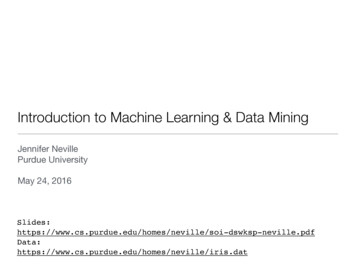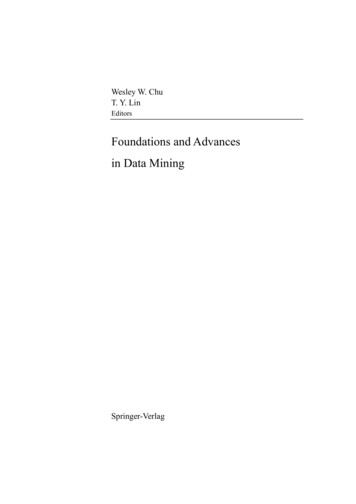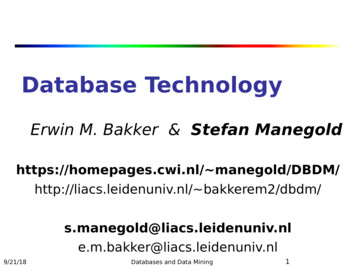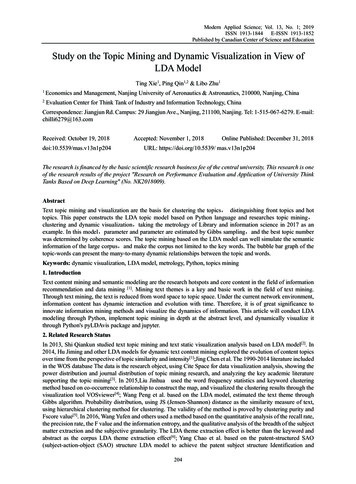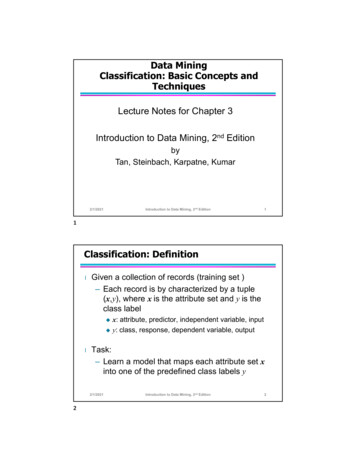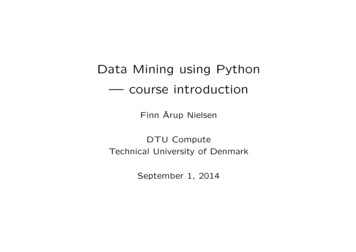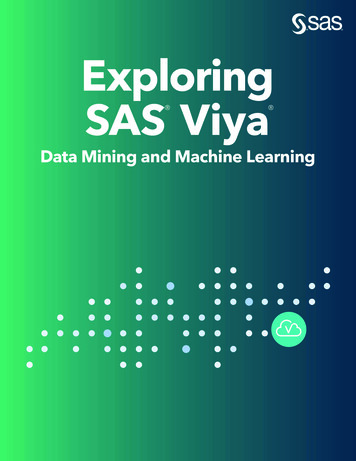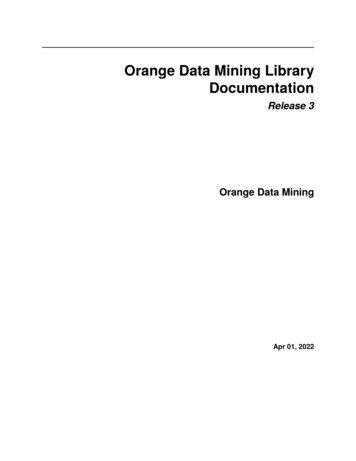
Transcription
Orange Data Mining LibraryDocumentationRelease 3Orange Data MiningApr 01, 2022
CONTENTS12Tutorial1.1 The Data . . . . . . . . . . . . . . . . .1.1.1Data Input . . . . . . . . . . . .1.1.2Creating a Data Table . . . . . .1.1.3Saving the Data . . . . . . . . .1.1.4Exploration of the Data Domain1.1.5Data Instances . . . . . . . . . .1.1.6Orange Datasets and NumPy . .1.1.7Meta Attributes . . . . . . . . .1.1.8Missing Values . . . . . . . . .1.1.9Data Selection and Sampling . .1.2 Classification . . . . . . . . . . . . . . .1.2.1Learners and Classifiers . . . . .1.2.2Probabilistic Classification . . .1.2.3Cross-Validation . . . . . . . .1.2.4Handful of Classifiers . . . . . .1.3 Regression . . . . . . . . . . . . . . . .1.3.1Handful of Regressors . . . . .1.3.2Cross Validation . . . . . . . .111344567991011121212141415Reference2.1 Data model (data) . . . . . . . . . . . . .2.1.1Data Storage (storage) . . . . .2.1.2Data Table (table) . . . . . . . .2.1.3SQL table (data.sql) . . . . . .2.1.4Domain description (domain) . .2.1.5Variable Descriptors (variable) .2.1.6Values (value) . . . . . . . . . .2.1.7Data Instance (instance) . . . .2.1.8Data Filters (filter) . . . . . . .2.1.9Loading and saving data (io) . . .2.2 Data Preprocessing (preprocess) . . . .2.2.1Impute . . . . . . . . . . . . . . .2.2.2Discretization . . . . . . . . . . .2.2.3Continuization . . . . . . . . . .2.2.4Normalization . . . . . . . . . . .2.2.5Randomization . . . . . . . . . .2.2.6Remove . . . . . . . . . . . . . .2.2.7Feature selection . . . . . . . . .2.2.8Preprocessors . . . . . . . . . . .1717182124262936373941434343444748484952i
2.3Outlier detection (classification) . . . . . . . . . . . .2.3.1One Class Support Vector Machines . . . . . . . .2.3.2Elliptic Envelope . . . . . . . . . . . . . . . . . .2.3.3Local Outlier Factor . . . . . . . . . . . . . . . . .2.3.4Isolation Forest . . . . . . . . . . . . . . . . . . .2.4 Classification (classification) . . . . . . . . . . . . . .2.4.1Logistic Regression . . . . . . . . . . . . . . . . .2.4.2Random Forest . . . . . . . . . . . . . . . . . . .2.4.3Simple Random Forest . . . . . . . . . . . . . . .2.4.4Softmax Regression . . . . . . . . . . . . . . . . .2.4.5k-Nearest Neighbors . . . . . . . . . . . . . . . .2.4.6Naive Bayes . . . . . . . . . . . . . . . . . . . . .2.4.7Support Vector Machines . . . . . . . . . . . . . .2.4.8Linear Support Vector Machines . . . . . . . . . .2.4.9Nu-Support Vector Machines . . . . . . . . . . . .2.4.10 Classification Tree . . . . . . . . . . . . . . . . .2.4.11 Simple Tree . . . . . . . . . . . . . . . . . . . . .2.4.12 Majority Classifier . . . . . . . . . . . . . . . . .2.4.13 Neural Network . . . . . . . . . . . . . . . . . . .2.4.14 CN2 Rule Induction . . . . . . . . . . . . . . . . .2.4.15 Calibration and threshold optimization . . . . . . .2.4.16 Gradient Boosted Trees . . . . . . . . . . . . . . .2.5 Regression (regression) . . . . . . . . . . . . . . . . . .2.5.1Linear Regression . . . . . . . . . . . . . . . . . .2.5.2Polynomial . . . . . . . . . . . . . . . . . . . . .2.5.3Mean . . . . . . . . . . . . . . . . . . . . . . . .2.5.4Random Forest . . . . . . . . . . . . . . . . . . .2.5.5Simple Random Forest . . . . . . . . . . . . . . .2.5.6Regression Tree . . . . . . . . . . . . . . . . . . .2.5.7Neural Network . . . . . . . . . . . . . . . . . . .2.5.8Gradient Boosted Trees . . . . . . . . . . . . . . .2.5.9Curve Fit . . . . . . . . . . . . . . . . . . . . . .2.6 Clustering (clustering) . . . . . . . . . . . . . . . . . .2.6.1Hierarchical (hierarchical) . . . . . . . . . . .2.7 Distance (distance) . . . . . . . . . . . . . . . . . . . . .2.7.1Handling discrete and missing data . . . . . . . . .2.7.2Supported distances . . . . . . . . . . . . . . . . .2.8 Evaluation (evaluation) . . . . . . . . . . . . . . . . . .2.8.1Sampling procedures for testing models (testing)2.8.2Scoring methods (scoring) . . . . . . . . . . . .2.8.3Performance curves . . . . . . . . . . . . . . . . .2.9 Projection (projection) . . . . . . . . . . . . . . . . . .2.9.1PCA . . . . . . . . . . . . . . . . . . . . . . . . .2.9.2FreeViz . . . . . . . . . . . . . . . . . . . . . . .2.9.3LDA . . . . . . . . . . . . . . . . . . . . . . . . .2.9.4References . . . . . . . . . . . . . . . . . . . . . .2.10 Miscellaneous (misc) . . . . . . . . . . . . . . . . . . . .2.10.1 Distance Matrix (distmatrix) . . . . . . . . . . liography95Python Module Index97Index99ii
CHAPTERONETUTORIALThis is a gentle introduction on scripting in Orange , a Python 3 data mining library. We here assume you have alreadydownloaded and installed Orange from its github repository and have a working version of Python. In the commandline or any Python environment, try to import Orange. Below, we used a Python shell:% python import Orange Orange.version.version'3.25.0.dev0 3bdef92' If this leaves no error and warning, Orange and Python are properly installed and you are ready to continue with thetutorial.1.1 The DataThis section describes how to load the data in Orange. We also show how to explore the data, perform some basicstatistics, and how to sample the data.1.1.1 Data InputOrange can read files in proprietary tab-delimited format, or can load data from any of the major standard spreadsheetfile types, like CSV and Excel. Native format starts with a header row with feature (column) names. The second headerrow gives the attribute type, which can be numeric, categorical, time, or string. The third header line contains metainformation to identify dependent features (class), irrelevant features (ignore) or meta features (meta). More detailedspecification is available in Loading and saving data (io). Here are the first few lines from a dataset icdiscretetear oneValues are tab-limited. This dataset has four attributes (age of the patient, spectacle prescription, notion on astigmatism,and information on tear production rate) and an associated three-valued dependent variable encoding lens prescriptionfor the patient (hard contact lenses, soft contact lenses, no lenses). Feature descriptions could use one letter only, sothe header of this dataset could also read:1
Orange Data Mining Library Documentation, Release 3agedprescriptiondastigmaticdtear ratedlensesdcThe rest of the table gives the data. Note that there are 5 instances in our table above. For the full dataset, check outor download lenses.tab) to a target directory. You can also skip this step as Orange comes preloaded with severaldemo datasets, lenses being one of them. Now, open a python shell, import Orange and load the data: import Orange data Orange.data.Table("lenses") Note that for the file name no suffix is needed, as Orange checks if any files in the current directory are of a readabletype. The call to Orange.data.Table creates an object called data that holds your dataset and information about thelenses domain: data.domain.attributes(DiscreteVariable('age', values ('pre-presbyopic', 'presbyopic', 'young')),DiscreteVariable('prescription', values ('hypermetrope', 'myope')),DiscreteVariable('astigmatic', values ('no', 'yes')),DiscreteVariable('tear rate', values ('normal', 'reduced'))) data.domain.class varDiscreteVariable('lenses', values ('hard', 'none', 'soft')) for d in data[:3]:.:print(d).:[young, myope, no, reduced none][young, myope, no, normal soft][young, myope, yes, reduced none] The following script wraps-up everything we have done so far and lists first 5 data instances with soft prescription:import Orangedata Orange.data.Table("lenses")print("Attributes:", ", ".join(x.name for x in data.domain.attributes))print("Class:", data.domain.class var.name)print("Data instances", len(data))target "soft"print("Data instances with %s prescriptions:" % target)atts data.domain.attributesfor d in data:if d.get class() target:print(" ".join(["%14s" % str(d[a]) for a in atts]))Note that data is an object that holds both the data and information on the domain. We show above how to accessattribute and class names, but there is much more information there, including that on feature type, set of values forcategorical features, and other.2Chapter 1. Tutorial
Orange Data Mining Library Documentation, Release 31.1.2 Creating a Data TableTo create a data table from scratch, one needs two things, a domain and the data. The domain is the description of thevariables, i.e. column names, types, roles, etc.First, we create the said domain. We will create three types of variables, numeric (ContiniousVariable), categorical(DiscreteVariable) and text (StringVariable). Numeric and categorical variables will be used a features (also known asX), while the text variable will be used as a meta variable. from Orange.data import Domain, ContinuousVariable,DiscreteVariable, StringVariable domain e("col2", values ["red", "blue"])],metas [StringVariable("col3")])Now, we will build the data with numpy. import numpy as npcolumn1 np.array([1.2, 1.4, 1.5, 1.1, 1.2])column2 np.array([0, 1, 1, 1, 0])column3 np.array(["U13", "U14", "U15", "U16", "U17"], dtype object)Two things to note here. column2 has values 0 and 1, even though we specified it will be a categorical variable withvalues “red” and “blue”. X (features in the data) can only be numbers, so the numpy matrix will contain numbers,while Orange will handle the categorical representation internally. 0 will be mapped to the value “red” and 1 to “blue”(in the order, specified in the domain).Text variable requires dtype object for numpy to handle it correctly.Next, variables have to be transformed to a matrix. X np.column stack((column1, column2)) M column3.reshape(-1, 1)Finally, we create a table. We need a domain and variables, which can be passed as X (features), Y (class variable) ormetas. table Table.from numpy(domain, X X, metas M) print(table) [[1.2, red] {U13},[1.4, blue] {U14},[1.5, blue] {U15},[1.1, blue] {U16},[1.2, red] {U17}]To add a class variable to the table, the procedure would be the same, with the class variable passed as Y (e.g. table Table.from numpy(domain, X X, Y Y, metas M)).To add a single column to the table, one can use the Table.add column() method. new var DiscreteVariable("var4", values ["one", "two"])var4 np.array([0, 1, 0, 0, 1]) # no reshaping necessarytable table.add column(new var, var4)print(table)(continues on next page)1.1. The Data3
Orange Data Mining Library Documentation, Release 3(continued from previous page) [[1.2, red, one] {U13},[1.4, blue, two] {U14},[1.5, blue, one] {U15},[1.1, blue, one] {U16},[1.2, red, two] {U17}]1.1.3 Saving the DataData objects can be saved to a file: data.save("new data.tab") This time, we have to provide the file extension to specify the output format. An extension for native Orange’s dataformat is “.tab”. The following code saves only the data items with myope perscription:import Orangedata Orange.data.Table("lenses")myope subset [d for d in data if d["prescription"] "myope"]new data Orange.data.Table(data.domain, myope subset)new data.save("lenses-subset.tab")We have created a new data table by passing the information on the structure of the data (data.domain) and a subsetof data instances.1.1.4 Exploration of the Data DomainData table stores information on data instances as well as on data domain. Domain holds the names of attributes,optional classes, their types and, and if categorical, the value names. The following code:import Orangedata Orange.data.Table("imports-85.tab")n len(data.domain.attributes)n cont sum(1 for a in data.domain.attributes if a.is continuous)n disc sum(1 for a in data.domain.attributes if a.is discrete)print("%d attributes: %d continuous, %d discrete" % (n, n cont, n disc))print("First three attributes:",", ".join(data.domain.attributes[i].name for i in range(3)),)print("Class:", data.domain.class var.name)outputs:25 attributes: 14 continuous, 11 discreteFirst three attributes: symboling, normalized-losses, makeClass: price4Chapter 1. Tutorial
Orange Data Mining Library Documentation, Release 3Orange’s objects often behave like Python lists and dictionaries, and can be indexed or accessed through feature names:print("First attribute:", data.domain[0].name)name "fuel-type"print("Values of attribute '%s': %s" % (name, ", ".join(data.domain[name].values)))The output of the above code is:First attribute: symbolingValues of attribute 'fuel-type': diesel, gas1.1.5 Data InstancesData table stores data instances (or examples). These can be indexed or traversed as any Python list. Data instancescan be considered as vectors, accessed through element index, or through feature name.import Orangedata Orange.data.Table("iris")print("First three data instances:")for d in data[:3]:print(d)print("25-th data instance:")print(data[24])name "sepal width"print("Value of '%s' for the first instance:" % name, data[0][name])print("The 3rd value of the 25th data instance:", data[24][2])The script above displays the following output:First three data instances:[5.100, 3.500, 1.400, 0.200 Iris-setosa][4.900, 3.000, 1.400, 0.200 Iris-setosa][4.700, 3.200, 1.300, 0.200 Iris-setosa]25-th data instance:[4.800, 3.400, 1.900, 0.200 Iris-setosa]Value of 'sepal width' for the first instance: 3.500The 3rd value of the 25th data instance: 1.900The Iris dataset we have used above has four continuous attributes. Here’s a script that computes their mean:average lambda x: sum(x) / len(x)data Orange.data.Table("iris")print("%-15s %s" % ("Feature", "Mean"))for x in data.domain.attributes:print("%-15s %.2f " % (x.name, average([d[x] for d in data])))The above script also illustrates indexing of data instances with objects that store features; in d[x] variable x is anOrange object. Here’s the output:1.1. The Data5
Orange Data Mining Library Documentation, Release 3Featuresepal lengthsepal widthpetal lengthpetal widthMean5.843.053.761.20A slightly more complicated, but also more interesting, code that computes per-class averages:average lambda xs: sum(xs) / float(len(xs))data Orange.data.Table("iris")targets data.domain.class var.valuesprint("%-15s %s" % ("Feature", " ".join("%15s" % c for c in targets)))for a in data.domain.attributes:dist ["%15.2f " % average([d[a] for d in data if d.get class() c]) for c in targets]print("%-15s" % a.name, " ".join(dist))Of the four features, petal width and length look quite discriminative for the type of iris:Featuresepal lengthsepal widthpetal lengthpetal widthIris-setosa s-virginica6.592.975.552.03Finally, here is a quick code that computes the class distribution for another dataset:import Orangefrom collections import Counterdata Orange.data.Table("lenses")print(Counter(str(d.get class()) for d in data))1.1.6 Orange Datasets and NumPyOrange datasets are actually wrapped NumPy arrays. Wrapping is performed to retain the information about the featurenames and values, and NumPy arrays are used for speed and compatibility with different machine learning toolboxes,like scikit-learn, on which Orange relies. Let us display the values of these arrays for the first three data instances ofthe iris dataset: data Orange.data.Table("iris") data.X[:3]array([[ 5.1, 3.5, 1.4, 0.2],[ 4.9, 3. , 1.4, 0.2],[ 4.7, 3.2, 1.3, 0.2]]) data.Y[:3]array([ 0., 0., 0.])Notice that we access the arrays for attributes and class separately, using data.X and data.Y. Average values ofattributes can then be computed efficiently by:6Chapter 1. Tutorial
Orange Data Mining Library Documentation, Release 3 import np as numpy np.mean(data.X, axis 0)array([ 5.84333333, 3.054,3.75866667,1.19866667])We can also construct a (classless) dataset from a numpy array: X np.array([[1,2], [4,5]]) data Orange.data.Table(X) data.domain[Feature 1, Feature 2]If we want to provide meaninful names to attributes, we need to construct an appropriate data domain: domain ]) data Orange.data.Table(domain, X) data.domain[lenght, width]Here is another example, this time with the construction of a dataset that includes a numerical class and different typesof attributes:size Orange.data.DiscreteVariable("size", ["small", "big"])height Orange.data.ContinuousVariable("height")shape Orange.data.DiscreteVariable("shape", ["circle", "square", "oval"])speed Orange.data.ContinuousVariable("speed")domain Orange.data.Domain([size, height, shape], speed)X np.array([[1, 3.4, 0], [0, 2.7, 2], [1, 1.4, 1]])Y np.array([42.0, 52.2, 13.4])data Orange.data.Table(domain, X, Y)print(data)Running of this scripts yields:[[big, 3.400, circle 42.000],[small, 2.700, oval 52.200],[big, 1.400, square 13.400]1.1.7 Meta AttributesOften, we wish to include descriptive fields in the data that will not be used in any computation (distance estimation,modeling), but will serve for identification or additional information. These are called meta attributes, and are markedwith meta in the third header inues on next page)1.1. The Data7
Orange Data Mining Library Documentation, Release 3(continued from previous page)bassbear0110011104fishmammalValues of meta attributes and all other (non-meta) attributes are treated similarly in Orange, but stored in separatenumpy arrays: data pe"]for d in data:.:print("{}/{}: {}".format(d["name"], d["type"], d["legs"])).:aardvark/mammal: 4antelope/mammal: 4bass/fish: 0bear/mammal: 4 data.Xarray([[ 1., 0., 1., 1., 2.],[ 1., 0., 1., 1., 2.],[ 0., 1., 0., 1., 0.],[ 1., 0., 1., 1., 2.]])) ],['bear']], dtype object))Meta attributes may be passed to Orange.data.Table after providing arrays for attribute and class values:from Orange.data import Table, Domainfrom Orange.data import ContinuousVariable, DiscreteVariable, StringVariableimport numpy as npX np.array([[2.2, 1625], [0.3, 163]])Y np.array([0, 1])M np.array([["houston", 10], ["ljubljana", -1]])domain Domain([ContinuousVariable("population"), w", ("no", "yes"))],[StringVariable("city"), StringVariable("temperature")],)data Table(domain, X, Y, M)print(data)The script outputs:[[2.200, 1625.000 no] {houston, 10},[0.300, 163.000 yes] {ljubljana, -1}To construct a classless domain we could pass None for the class values.8Chapter 1. Tutorial
Orange Data Mining Library Documentation, Release 31.1.8 Missing ValuesConsider the following exploration of the dataset on votes of the US senate: import numpy as np data Orange.data.Table("voting.tab") data[2][?, y, y, ?, y, . democrat] np.isnan(data[2][0])True np.isnan(data[2][1])FalseThe particular data instance included missing data (represented with ‘?’) for the first and the fourth attribute. In theoriginal dataset file, the missing values are, by default, represented with a blank space. We can now examine eachattribute and report on proportion of data instances for which this feature was undefined:data Orange.data.Table("voting.tab")for x in data.domain.attributes:n miss sum(1 for d in data if np.isnan(d[x]))print("%4.1f %% %s" % (100.0 * n miss / len(data), x.name))First three lines of the output of this script are:2.8% handicapped-infants11.0% water-project-cost-sharing2.5% adoption-of-the-budget-resolutionA single-liner that reports on number of data instances with at least one missing value is: sum(any(np.isnan(d[x]) for x in data.domain.attributes) for d in data)2031.1.9 Data Selection and SamplingBesides the name of the data file, Orange.data.Table can accept the data domain and a list of data items and returnsa new dataset. This is useful for any data subsetting:data Orange.data.Table("iris.tab")print("Dataset instances:", len(data))subset Orange.data.Table(data.domain, [d for d in data if d["petal length"] 3.0])print("Subset size:", len(subset))The code outputs:Dataset instances: 150Subset size: 99and inherits the data description (domain) from the original dataset. Changing the domain requires setting up a newdomain descriptor. This feature is useful for any kind of feature selection:data Orange.data.Table("iris.tab")new domain Orange.data.Domain((continues on next page)1.1. The Data9
Orange Data Mining Library Documentation, Release 3(continued from previous class var)new data Orange.data.Table(new domain, data)print(data[0])print(new data[0])We could also construct a random sample of the dataset: sample Orange.data.Table(data.domain, random.sample(data, 3)) sample[[6.000, 2.200, 4.000, 1.000 Iris-versicolor],[4.800, 3.100, 1.600, 0.200 Iris-setosa],[6.300, 3.400, 5.600, 2.400 Iris-virginica]]or randomly sample the attributes: atts random.sample(data.domain.attributes, 2) domain Orange.data.Domain(atts, data.domain.class var) new data Orange.data.Table(domain, data) new data[0][5.100, 1.400 Iris-setosa]1.2 ClassificationMuch of Orange is devoted to machine learning methods for classification, or supervised data mining. These methodsrely on data with class-labeled instances, like that of senate voting. Here is a code that loads this dataset, displays thefirst data instance and shows its predicted class (republican): [n,import Orangedata Orange.data.Table("voting")data[0]y, n, y, y, . republican]Orange implements functions for construction of classification models, their evaluation and scoring. In a nutshell, hereis the code that reports on cross-validated accuracy and AUC for logistic regression and random forests:import Orangedata Orange.data.Table("voting")lr f Orange.classification.RandomForestLearner(n estimators 100)res Orange.evaluation.CrossValidation(data, [lr, rf], k 5)print("Accuracy:", Orange.evaluation.scoring.CA(res))print("AUC:", Orange.evaluation.scoring.AUC(res))It turns out that for this domain logistic regression does well:10Chapter 1. Tutorial
Orange Data Mining Library Documentation, Release 3Accuracy: [ 0.96321839 0.95632184]AUC: [ 0.96233796 0.95671252]For supervised learning, Orange uses learners. These are objects that receive the data and return classifiers. Learnersare passed to evaluation routines, such as cross-validation above.1.2.1 Learners and ClassifiersClassification uses two types of objects: learners and classifiers. Learners consider class-labeled data and return aclassifier. Given the first three data instances, classifiers return the indexes of predicted class: import Orange data Orange.data.Table("voting") learner Orange.classification.LogisticRegressionLearner() classifier learner(data) classifier(data[:3])array([ 0., 0., 1.])Above, we read the data, constructed a logistic regression learner, gave it the dataset to construct a classifier, and usedit to predict the class of the first three data instances. We also use these concepts in the following code that predicts theclasses of the selected three instances in the dataset:learner lassifier learner(data)c values data.domain.class var.valuesfor d in data[5:8]:c classifier(d)print("{}, originally {}".format(c values[int(classifier(d))], d.get class()))The script outputs:democrat, originally democratrepublican, originally democratrepublican, originally republicanLogistic regression has made a mistake in the second case, but otherwise predicted correctly. No wonder, since thiswas also the data it trained from. The following code counts the number of such mistakes in the entire dataset:data Orange.data.Table("voting")learner lassifier learner(data)x np.sum(data.Y ! classifier(data))1.2. Classification11
Orange Data Mining Library Documentation, Release 31.2.2 Probabilistic ClassificationTo find out what is the probability that the classifier assigns to, say, democrat class, we need to call the classifier withan additional parameter that specifies the classification output type.data Orange.data.Table("voting")learner lassifier learner(data)target class 1print("Probabilities for %s:" % data.domain.class var.values[target class])probabilities classifier(data, 1)for p, d in zip(probabilities[5:8], data[5:8]):print(p[target class], d.get class())The output of the script also shows how badly the logistic regression missed the class in the second case:Probabilities for democrat:0.999506847581 democrat0.201139534658 democrat0.042347504805 republican1.2.3 Cross-ValidationValidating the accuracy of classifiers on the training data, as we did above, serves demonstration purposes only. Anyperformance measure that assesses accuracy should be estimated on the independent test set. Such is also a procedurecalled cross-validation, which averages the evaluation scores across several runs, each time considering a differenttraining and test subsets as sampled from the original dataset:data Orange.data.Table("titanic")lr es Orange.evaluation.CrossValidation(data, [lr], k 5)print("Accuracy: %.3f " % 3f " % tion is expecting a list of learners. The performance estimators also return a list of scores, one for everylearner. There was just one learner (lr) in the script above, hence an array of length one was returned. The scriptestimates classification accuracy and area under ROC curve:Accuracy: 0.779AUC:0.7041.2.4 Handful of ClassifiersOrange includes a variety of classification algorithms, most of them wrapped from scikit-learn, including: logistic regression (Orange.classification.LogisticRegressionLearner) k-nearest neighbors (Orange.classification.knn.KNNLearner) support vector machines (say, Orange.classification.svm.LinearSVMLearner) classification trees (Orange.classification.tree.SklTreeLearner) random forest er 1. Tutorial
Orange Data Mining Library Documentation, Release 3Some of these are included in the code that estimates the probability of a target class on a testing data. This time,training and test datasets are disjoint:import Orangeimport randomrandom.seed(42)data Orange.data.Table("voting")test Orange.data.Table(data.domain, random.sample(data, 5))train Orange.data.Table(data.domain, [d for d in data if d not in test])tree Orange.classification.tree.TreeLearner(max depth 3)knn Orange.classification.knn.KNNLearner(n neighbors 3)lr Orange.classification.LogisticRegressionLearner(C 0.1)learners [tree, knn, lr]classifiers [learner(train) for learner in learners]target 0print("Probabilities for %s:" % data.domain.class var.values[target])print("original class ", " ".join("%-5s" % l.name for l in classifiers))c values data.domain.class var.valuesfor d in test:print(("{: 15}" " {:.3f}" *
CHAPTER ONE TUTORIAL ThisisagentleintroductiononscriptinginOran



